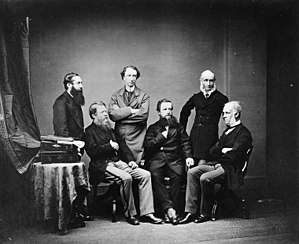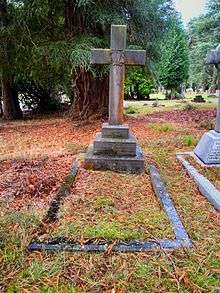Edward Thornton, 2nd Count of Cacilhas
Sir Edward Thornton GCB (13 July 1817 – 26 January 1906) was a prominent British diplomat, who held posts in Latin America, Turkey, Russia, and served for fourteen years as Minister to the United States.[1]


Early career
Thornton was born in London, the son of Sir Edward Thornton, also a diplomat, who for many years held the post of British Minister to Portugal.[1]

Thornton was educated at King's College London, and at Pembroke College, Cambridge.[1][2][3] He entered the diplomatic service as attaché to the mission at Turin in 1842, filled the same position in Mexico in 1845, and was made Secretary of Legation in that Capital in 1853.[1][3] Thornton did much to forward the conclusion of the Treaty of Guadalupe Hidalgo in 1848. In 1852, he was appointed Secretary of Legation at Buenos Aires, and chargé d'affaires to Uruguay in 1854.[3] He was appointed Minister to the Argentine Republic in 1859, and to Brazil in 1865.[1][3]
Paraguay
In November 1859, Thornton ordered the Royal Navy to attack the Paraguyan war steamer Tacuari, which future president Francisco Solano López was on, to pressure his father President Carlos López to release a British citizen from prison.[4] This was one of several incidents that damaged Paraguayan relations with Britain. Thornton would later apologise for the action to repair relations, and promised Britain had no intention of interfering with Paraguayan jurisdiction. His actions were used in a House of Commons debate on a clash with Brazil, with William "Seymour" Vesey-FitzGerald calling him "a gentleman who knows how to conciliate... that it is not his duty to "read lessons" to foreign Governments" as an attack on Brazilian consul William Dougal Christie, while opposing MP Layard pointed to Thornton as proof that Britain did not take a "high hand" with Latin American states. At the time, there was a belief that Latin American states were troublesome and a cause of strife.[5]
Later, Thornton was involved in the creation of the Triple Alliance in the Paraguayan War. Thornton encouraged the leaders of Argentina, Brazil, and Uruguay, while British banks provided the three nations with funding for their military campaigns.[6] Some historians have claimed that this was an official British government decision, as they wanted to see Paraguay opened to expanded British trade and investment.[6] Other historians have disputed this, pointing to Britain's lack of interest in the war and its discontent with the secret parts of the Treaty of the Triple Alliance.[7] However, it is known that Thornton was personally in favour of the Triple Alliance against Paraguay – he was present at the signing of a Treaty – and a strong supporter of Argentina's President Mitre, while being personally opposed to President Lopez. Thornton had been briefly replaced by Sir William Doria, who condemned Argentine intervention in Uruguay, but upon returning he reversed Doria's decisions and threw his support back behind Mitre.[7]
The war would continue after Thornton left Brazil, and left Paraguay utterly devastated and with nearly half its population dead.[8]
Minister to the United States

Thornton's lengthiest assignment was as Minister to the United States, a position he held for fourteen years (1867–1881).[1]
In 1871, Thornton served as a member of the commission on the Alabama Claims, and was appointed Privy Councilor.[1] Thornton served in 1873 as an arbitrator in the commission on the Mexican and United States Claims.[1][3] He was appointed Ambassador at St. Petersburg in 1881.[1][3] For his services Thornton was invested Knight Grand Cross of the Order of the Bath in 1883.[1][3] A year later Thornton received his last appointment, Ambassador at Constantinople, a position he held for three years before retiring.[1][3]
Thornton died at his London residence, 5 Tedworth Sq., after what was described as a lengthy illness.[1] He is buried in Brookwood Cemetery.
References
- "Death List of a Day. Sir Edward Thornton." The New York Times, 27 January 1906. Pg. 9. Accessed: 18 July 2009.
- "Thornton, Edward (THNN834E)". A Cambridge Alumni Database. University of Cambridge.
- Henry Robert Addison, Charles Henry Oakes, William John Lawson, Douglas Brooke Wheelton Sladen, ed. Who's Who: An Annual Biographical Dictionary, Page 1617 – London: Adam and Charles Black, 1904
- TRATADO DE LAS PUNTAS DEL ROSARIO (Guerra del Paraguay) (in Spanish)
- Commons Sitting – BRAZIL.—PAPER MOVED FOR −887 Hansard 16 July 1863
- Katra, William H. The Argentine Generation of 1837: Echeverria, Alberdi, Sarmiento, Mitre, page 261. Fairleigh Dickinson University Press, 1996
- Historia General de las relaciones internacionales de la República Argentina (in Spanish)
- War of the Triple Alliance. (2009). In Encyclopædia Britannica. Retrieved 18 July 2009, from Encyclopædia Britannica Online: http://www.britannica.com/EBchecked/topic/442711/War-of-the-Triple-Alliance
External links
| Wikimedia Commons has media related to Edward Thornton (diplomat). |
| Diplomatic posts | ||
|---|---|---|
| Preceded by Sir Frederick Bruce |
British Minister to the United States 1867–1881 |
Succeeded by Lionel Sackville-West |
- This article incorporates text from a publication now in the public domain: Gilman, D. C.; Peck, H. T.; Colby, F. M., eds. (1905). New International Encyclopedia (1st ed.). New York: Dodd, Mead. Missing or empty
|title=(help)